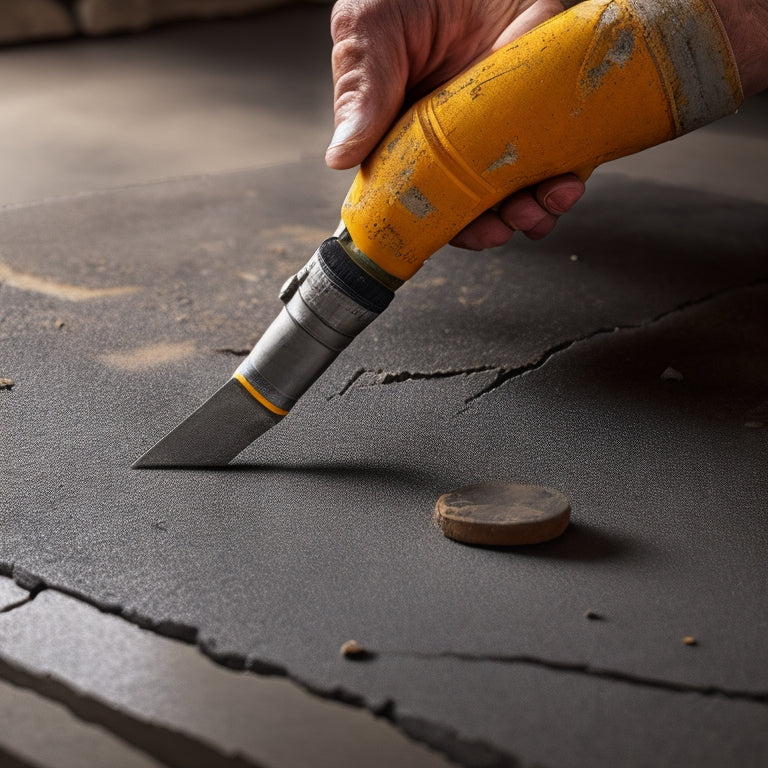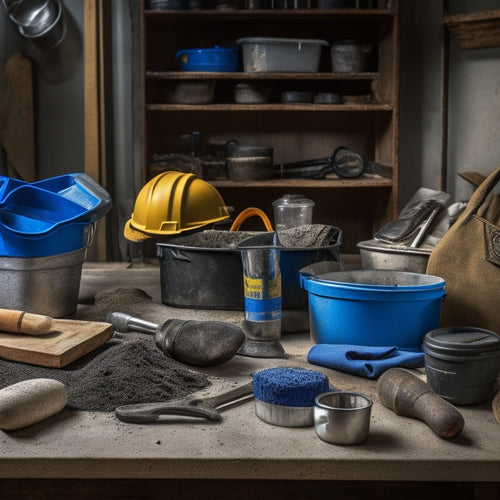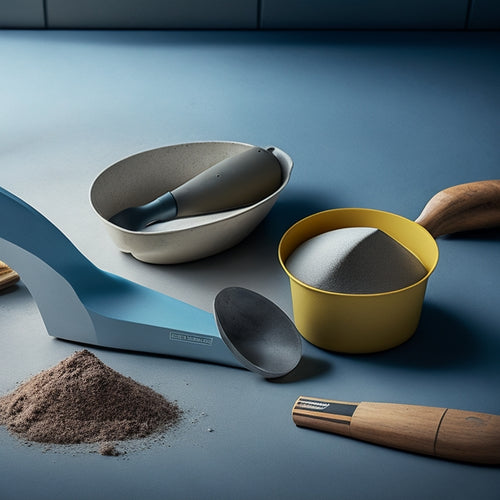
3 Best Concrete Crack Repair Tools for DIY
Share
When tackling a DIY concrete crack repair, you'll need the right tools for a professional-looking finish. For a solid fix, you can't go wrong with a putty knife for scraping dirt and debris, a caulk gun for precise sealant application, and a wire brush or scraper for removing old sealants and loose concrete. With these essentials in your toolkit, you'll be well on your way to a successful repair. But that's just the starting point - you'll want to make sure you're using the best techniques and materials for a long-lasting fix, and we'll explore that further.
Key Takeaways
• A putty knife is essential for scraping dirt and debris from cracks before applying sealants.
• A trowel helps apply bonding agents or primers for a strong sealant bond.
• A caulk gun provides precise application of sealants, especially in small cracks.
• A wire brush or scraper is necessary for removing old sealants and loose concrete.
• Safety glasses and gloves are crucial for protecting yourself during the repair process.
Top Picks for DIY Repair
When tackling a DIY concrete crack repair, you'll need the right tools to guarantee a successful and long-lasting fix.
To achieve this, it's vital to master effective repair techniques. Start by preparing the surface by cleaning the crack thoroughly with a wire brush to remove dirt and debris. Next, use a degreaser to remove any oil or grease that may be present. This step is significant, as it secures a strong bond between the concrete and the repair material.
Once the surface is prepared, you can move on to the repair itself. For small cracks, you can use a concrete patching compound, while larger cracks may require a more extensive repair involving epoxy or polyurethane-based materials.
Regardless of the material you choose, make sure to follow the manufacturer's instructions and apply it according to their recommendations. By focusing on proper surface preparation and using the right repair techniques, you'll be well on your way to a successful DIY concrete crack repair.
Essential Tools for Sealing Cracks
You'll frequently reach for a few essential tools to seal cracks effectively, including a putty knife, trowel, and caulk gun. These tools will help you prepare the surface and fill the crack properly. A putty knife is perfect for scraping away dirt and debris from the crack, guaranteeing a clean surface for sealing. A trowel, on the other hand, is great for applying a bonding agent or primer to the surface, which helps the sealant adhere better.
For crack detection, you might need a flashlight and a pair of safety glasses to get a closer look. Don't forget to wear gloves to protect your hands from harsh chemicals and rough surfaces.
When it comes to surface preparation, a wire brush or a scraper can come in handy to remove old sealants, dirt, or loose concrete. Make certain to clean the area thoroughly before applying any sealant.
With these essential tools, you'll be well-equipped to tackle crack sealing like a pro. Remember to always follow the manufacturer's instructions for each tool and sealant to guarantee a successful repair.
Best Sealants for Concrete Walls
With your tools ready and surface prepared, it's time to select the right sealant for your concrete wall repair. You'll find various sealant types on the market, each suited for specific tasks and environmental conditions.
For general-purpose repairs, acrylic or silicone-based sealants are popular choices. They're easy to apply, dry quickly, and provide excellent flexibility. Epoxy-based sealants, on the other hand, offer superior strength and durability, making them ideal for high-traffic areas or structural repairs.
When choosing a sealant, consider the application method as well. Some sealants come in cartridges, suitable for small cracks and crevices, while others are best applied with a brush or roller for larger areas.
Make certain to read the product instructions for specific application guidelines. Additionally, consider the color and finish you want to achieve, as some sealants can be tinted to match your wall's original color.
Frequently Asked Questions
Can I Use Bleach to Clean Concrete Cracks Before Sealing?
When preparing concrete cracks for sealing, you're wondering if bleach can be used for cleaning.
While bleach might seem effective, it's not the best choice. Bleach can weaken the concrete's surface, making it more prone to further damage.
Instead, opt for a gentle concrete cleaner or a mixture of trisodium phosphate and water.
These solutions will effectively clean the cracks without compromising the concrete's integrity, ensuring a stronger seal in the long run.
Do I Need to Remove Old Sealant Before Reapplying?
When reapplying sealant, you'll typically need to remove the old one to guarantee a strong bond.
The type of sealant you're using determines the removal technique. For acrylic or latex-based sealants, scrape them off with a putty knife or wire brush.
For epoxy or polyurethane-based sealants, you'll need to use a solvent or specialized remover.
Always follow the manufacturer's instructions for removal and preparation before reapplying a new sealant.
Will Concrete Crack Repair Tools Work on Hairline Cracks?
Get ready to zoom in on those tiny cracks!
When it comes to hairline cracks, you're probably wondering if concrete repair tools will get the job done.
The truth is, it all depends on your hairline crack assessment. If the crack is shallow and clean, a good repair tool can be effective.
But if the crack is deep or has dirt/debris, you'll need a more heavy-duty solution.
Don't worry, with the right tool, you'll be sealing like a pro in no time!
Can I Repair Cracks in Concrete Floors With Epoxy?
You're wondering if you can repair cracks in concrete floors with epoxy. The answer is yes, you can!
Epoxy is a great choice for concrete crack repair because it's strong, flexible, and resistant to chemicals. When applied correctly, epoxy can restore concrete durability and prevent further damage.
For a successful epoxy application, make sure the crack is clean and dry, then follow the manufacturer's instructions for mixing and applying the epoxy.
How Long Does It Take for Concrete Sealant to Fully Dry?
You're wondering how long it takes for concrete sealant to fully dry.
Well, the drying time varies depending on the type of sealant and environmental conditions.
On average, it can take anywhere from 30 minutes to 24 hours for the sealant to dry to the touch.
However, it may take up to 72 hours for it to fully cure and reach its maximum sealant effectiveness.
Be patient and follow the manufacturer's instructions for the best results.
Conclusion
You've made it to the end of our guide, and now you're ready to tackle that concrete crack repair job like a pro!
With the right tools and sealants, you'll be amazed at how easy it is to restore your walls and floors to their former glory.
Did you know that 75% of concrete cracks can be prevented with proper installation and maintenance?
By following our tips and using the best concrete crack repair tools, you can join the ranks of the crack-free concrete elite!
Related Posts
-

5 Tools Needed for Quick Fix Concrete Mixing
You'll need five essential tools to tackle a quick fix concrete mixing project efficiently. First, you'll require a s...
-

Ergonomic Concrete Tools for Tight Spaces
When you're tackling concrete work in tight spaces, ergonomic tools are your best bet for comfort and efficiency. The...
-

Top Mixing Tools for DIY Concrete Block Laying
When it comes to DIY concrete block laying, the right mixing tools are vital for a strong and durable structure. You'...


